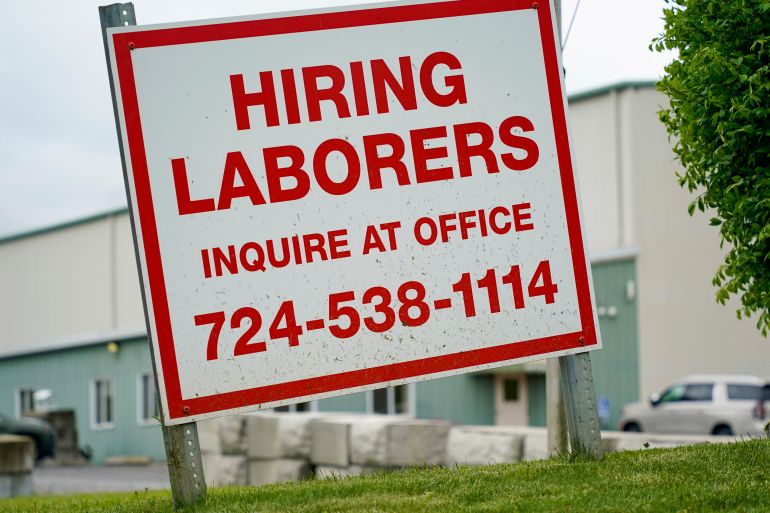US economy adds 266,000 jobs in April, in major expectations miss
The US economy added 266,000 jobs in April, but the gain fell far short of the blockbuster one million jobs many analysts were expecting.

As jobs reports go, this one was a major disappointment.
The United States economy added 266,000 jobs in April, the Bureau of Labor Statistics (BLS) said on Friday. While any gain is far preferable to a loss, the headline number was massively shy of the roughly one million non-farm payrolls many Wall Street economists were expecting.
Keep reading
list of 4 itemsWill the US unemployment rate continue at historic lows?
Is the US media layoffs phenomenon the next housing crisis?
First 100 days: Milei falters on shock therapy for Argentina’s economy
The unemployment rate in April was little changed at 6.1 percent, while jobs gains for March were revised downwards to a less robust 770,000, and February’s were revised up to 536,000.
The slowdown in jobs creation in April signals that the labour market recovery continues to lag the broader economic rebound as more Americans are vaccinated, and a heaping helping of federal virus relief aid helps US consumers rediscover their appetite for spending.
It also caught many economists off guard because claims for initial unemployment benefits filed with states have been dropping steadily, and even hit a new pandemic low last week.
“The more muted 266,000 increase in non-farm payrolls last month is a clear disappointment given the consensus and our own expectation for a one million-plus gain,” wrote Capital Economics Senior US Economist Michael Pearce in a note to clients on Friday. “With most of the high-frequency indicators still pointing to further improvement and jobless claims falling like a stone in recent weeks, however, we doubt that it signals the recovery is at risk. But it could indicate that labour shortages are becoming a significant drag.”
Labour shortages and political fodder
Leisure and hospitality, one of the sectors hardest-hit by COVID-19 restrictions, added 331,000 jobs in April, with more than half of that gain happening in restaurants, bars and other food service providers.
But April’s gains in leisure and hospitality were offset by losses in other sectors like manufacturing, which shed 18,000 jobs – largely due to automakers who have had to slow production due to shortages of semiconductors. Couriers and messengers, which boom when people stay at home, lost 77,000 jobs.
The nation’s labour market still has a long way to go to recover its pre-pandemic strength.
Of the 22 million jobs lost to the initial round of lockdowns in March and April of 2020, more than eight million have yet to be recovered – and that milestone does not take into account how much the labour force and the economy have grown since then.
But the jobs market is also showing some hallmarks of what economists typically consider being “tight” – when positions are plentiful and job seekers hold the upper hand.
Average hourly earnings last month edged up by 21 cents to $30.17, following a decline of 4 cents in March.
“The data for April suggest that the rising demand for labor associated with the recovery from the pandemic may have put upward pressure on wages,” said the BLS. It did note, however, that earnings variations across industries and large employment fluctuations since the start of the pandemic “complicate the analysis”.
On Thursday, the National Federation of Independent Business said that a record 44 percent of small business owners reported having job openings in April they could not fill.
“The tight labor market is the biggest concern for small businesses who are competing with various factors such as supplemental unemployment benefits, childcare and in-person school restrictions, and the virus,” said NFIB Chief Economist Bill Dunkelberg.
Openings that go begging can be a drag on monthly jobs creation. It is also fodder for a fierce political debate taking shape over how much federal aid is needed to heal the nation’s economy.
On Friday, US President Joe Biden seized upon the weaker-than-expected April jobs numbers to defend his $1.9 trillion American Rescue Plan of virus relief aid passed by Congress earlier this year.
But some believe that the $300 federal weekly top to state unemployment benefits that were extended through early September as part of the American Rescue Plan act as a disincentive for people to take low-wage jobs.
On Friday, the US Chamber of Commerce called on lawmakers in Washington to stop paying the $300 federal weekly top-up. “The disappointing jobs report makes it clear that paying people not to work is dampening what should be a stronger jobs market,” the business group’s Executive Vice President and Chief Policy Officer Neil Bradley said in a statement.
But there are other factors at play as well. Many working mothers have quit their jobs during the pandemic as they shouldered the brunt of increased eldercare and childcare responsibilities triggered by remote schooling and daycare centre closures.
The share of women over the age of 20 in the US who were either gainfully employed or actively looking for a job fell to 56.2 percent in April from 56.6 percent the months before.
Fear of being infected by COVID-19 is also a factor that may be keeping unemployed workers on the sidelines.
Some 45 percent of the US population has received at least one dose of a COVID-19 vaccine, while more than 32 percent are fully vaccinated, according to the US Centers for Disease Control and Prevention.